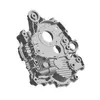Mobile:+86-311-808-126-83
Email:info@ydcastings.com
Advanced Techniques in Aluminum Pressure Die Casting for Enhanced Performance and Efficiency
Aluminum Pressure Die Casting A Comprehensive Overview
Aluminum pressure die casting is a highly efficient manufacturing process that allows for the production of intricate and precise metal components. This method leverages the properties of aluminum, paired with advanced casting techniques, to deliver high-quality products that meet the demanding specifications of various industries, including automotive, aerospace, electronics, and consumer goods.
The Basics of Aluminum Pressure Die Casting
At the core of pressure die casting is the use of high pressure to inject molten aluminum into a precisely designed mold. The process begins with heating aluminum to its molten state, reaching temperatures around 660°C (1220°F). The molten aluminum is then forced into a metal mold at high velocity. Once the metal fills the cavity, it cools and solidifies quickly, allowing for the production of parts with excellent surface finishes and dimensional accuracy.
The process is typically divided into two main types hot chamber and cold chamber die casting. Hot chamber die casting is used for alloys with lower melting points and allows for a quicker cycle time, making it more suitable for high-volume production. Conversely, cold chamber die casting is used for materials like aluminum, which have higher melting points. In this technique, the molten metal is poured into a chamber that is kept separate from the furnace, ensuring better control over the material's quality.
Benefits of Aluminum Pressure Die Casting
One of the primary advantages of aluminum pressure die casting is its ability to produce complex shapes with thin walls, which are often difficult to achieve with other manufacturing processes. This capability significantly reduces the need for secondary machining, thereby saving both time and costs. Moreover, the process yields components that are not only lightweight but also possess superior strength-to-weight ratios, making them ideal for applications where performance is critical.
Aluminum's natural corrosion resistance adds to the advantage of this casting method. Components produced through aluminum pressure die casting can withstand harsh environments, making them suitable for outdoor applications and industries such as automotive where vehicles are exposed to various weather conditions.
Another noteworthy benefit is the recyclability of aluminum. The scrap metal generated during the manufacturing process or from the end-of-life components can be easily melted down and reused to produce new parts. This aspect not only aligns with sustainable manufacturing practices but also contributes to cost savings in the long term.
aluminum pressure die casting

Quality Control and Process Optimization
To ensure the high quality of components produced through aluminum pressure die casting, stringent quality control measures are implemented throughout the manufacturing process. This includes monitoring the temperature and pressure during the injection phase, as well as conducting thorough inspections of the final products for defects such as porosity, surface irregularities, or dimensional inaccuracies.
Advanced technologies like computer-aided design (CAD) and computer-aided manufacturing (CAM) play a crucial role in optimizing the design and production processes. Simulations can predict how the molten aluminum will flow into the mold, helping engineers make informed adjustments to the mold design before production begins. This proactive approach minimizes material waste and enhances overall efficiency.
Applications Across Industries
The versatility of aluminum pressure die casting makes it suitable for a wide range of applications. In the automotive industry, it is used to manufacture components such as engine blocks, transmission cases, and structural frame parts. The aerospace industry benefits from lightweight yet robust components produced through this casting method, which are critical for fuel efficiency and performance.
In the electronics sector, aluminum die-cast housings and heat sinks are commonly produced to ensure optimal heat dissipation and protection of sensitive components. Additionally, consumer goods such as appliance casings and decorative elements often utilize this casting process due to the aesthetic finish that can be achieved.
Conclusion
Aluminum pressure die casting stands out as a revolutionary manufacturing technique that combines efficiency, precision, and sustainability. Its ability to produce high-quality components while minimizing waste and reducing processing times makes it an attractive option for various industries. As technology continues to advance, the potential for aluminum pressure die casting will likely expand, offering new opportunities for innovation and improved product design.
-
Why Should You Invest in Superior Pump Castings for Your Equipment?NewsJun.09,2025
-
Unlock Performance Potential with Stainless Impellers and Aluminum End CapsNewsJun.09,2025
-
Revolutionize Your Machinery with Superior Cast Iron and Aluminum ComponentsNewsJun.09,2025
-
Revolutionize Fluid Dynamics with Premium Pump ComponentsNewsJun.09,2025
-
Optimizing Industrial Systems with Essential Valve ComponentsNewsJun.09,2025
-
Elevate Grid Efficiency with High-Precision Power CastingsNewsJun.09,2025











